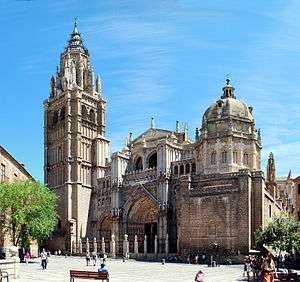Old Cathedral of Plasencia
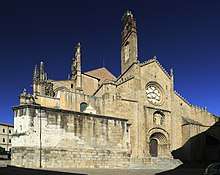
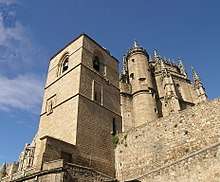
The Old Cathedral of Plasencia or Catedral de Santa María is a Catholic temple of the Spanish city of Plasencia (Province of Cáceres, Extremadura). It is one of the two buildings that make up the cathedral set of Plasencia. Commonly known as Old Cathedral of Plasencia, current Cathedral Museum of Plasencia, is a building that is an interesting example of transition from Romanesque to Gothic architecture and is one of the most notable buildings in the town. Its construction began at the beginning of the 13th century and the last protoGothic contributions occurred in the 15th century. During these centuries the works were carried out by teachers such as Juan Francés, Juan Pérez or Diego Díaz. It is currently considered as Bien de Interés Cultural.
History
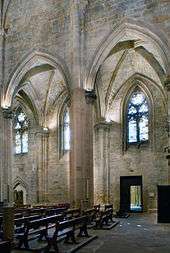
The Old cathedral of Plasencia is an example of a study as a transitional building from Romanesque to Gothic. To the first belong the fustis and capitals of its columns, while the Gothic its arches and windows, later and discovered in one of the last recent restorations. Its three naves were covered from the 18th century by a thick mantle of lime, which when disappearing, has allowed to admire the slenderness of a solemn temple.
During the second stage of construction, carried out throughout the 14th century, the church itself, the bell tower and the eastern and southern rooms of the cloister would be completed.
In the third and last stage, during the 15th century, the main chapel of the church was modified and the cloister was finished on the west and south sides. At this time, foundation problems were encountered, which caused the collapse of part of the western portal and whose reform was used to create new burial chapels in the temple. In this period and those who constituted the last masters of the temple were Juan Martín and Bishop Pedro Jiménez.
It was declared Monumento Histórico-Artístico belonging to the National Artistic Treasury by decree of June 3, 1931.[1] It is currently considered Bien de Interés Cultural.
Currently the temple is dedicated in part to the Cathedral Museum of Plasencia, which includes a remarkable set of paintings and sculptures by Spanish and Flemish artists such as Morales or Gerard David. It also has religious ornaments and cult objects from the 15th to the 17th centuries.
Building

In the parts that today are still standing, the Romanesque origins are visible, although sometimes the solutions used were close to proto-Gothic. It responded to the type of Romanesque church with three naves, with a larger central apse and two smaller ones on the sides, although currently there are three naves without any apse. The highest central nave maintains its original ribbed vaults with tiercerons and simple in the aisles.
In its origins, the back wall was formed by the main chapel, separated from the main nave by a small stairway. On both sides were two other smaller chapels. That of the Gospel side called that of the crucifijo and that of the Epistle side called of Nuestra Señora del Perdón or of the Blessed Sacrament, because the sanctuary is in it. The images that were in these chapels were emplaced in new locations, like the Chapel of San Pablo, or different dispositions in the New Cathedral. Currently in the central is venerated, in a small reredos, a size of the Virgin Child, of singular beauty.
Portal
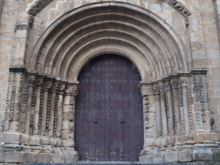
The main portal is a refined example of the Romanesque architecture, with semicircular arches with the classic archivolts on which, in a simple niche, there is a sculptural group carved in stone of the Annunciation of Our Lady, which appears also on the splendid rose window in a small image and before it a praying angel.
Currently it can also be accessed through the so-called Western Gate, a bad called del perdón, which would rather correspond to the missing of the northern transept, which dates back to the beginning of the 13th century.
Cloister
.jpg)
The cloister, of irregular plant, is of evident transition from Romanesque to Gothic, typical of the ancient Cathedral. Reminiscence of the Romanesque in its columns and capitals, with biblical scenes, and references to the Gothic in the arches and ribbed vaults. The west and south naves are of clear Cistercian style. The center of the courtyard is occupied by a Gothic fountain from the 15th century, with coats of arms of the bishop and cardinal Juan de Carvajal.
It currently serves as a point of encounter and union between both cathedrals and in its pavement hosts tombs of illustrious canons.
Chapel of San Pablo or Torre del Melón
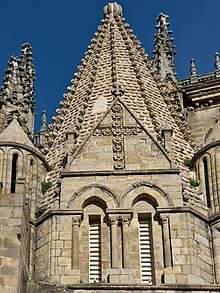
If there is a part of the Romanesque building that should stand out, it is undoubtedly the old Chapter House or Chapel of San Pablo and popularly known as Torre del Melón for the ending in a fluted ball.
The chapel of San Pablo follows the model of torres linterna or of the group of lantern towers of Kingdom of León of the cathedrals of Zamora and Salamanca, the collegiate church of Toro and without forgetting the cathedral of Évora, in Portugal. Its initial origin is to be found in French Romanesque, particularly in the religious buildings of the Poitou region. Undoubtedly, that of Plasencia is the latest of all and close in its construction to the Torre del Gallo of the Old Cathedral of Salamanca. The most suitable date for the completion of his works would be that of the year 1270, at the hands of the master Gil de Císlar, possible master stonemason trained in the workshop of Petrus Petri.
It is a room with a square floor, which becomes an octagon through ribbed tubes that make up a foiled vault of sixteen nerves. On the outside, the double canopy dome is a steep and conical element, covered with laves in the form of scales, which hinder the erosion that rainwater can produce. At the highest point it ends with a fluted ball, which has given rise to the popular name of Torre del Melón.
Sometimes changes in the use of the chapter house led to changes in adaptability, as occurred in 1508, when the library donated by Dr. Gutiérrez Álvarez was installed in it, or as in 1544, when it was converted into the Main Chapel while the back wall of the Cathedral was demolished.
See also
References
- ↑ Decree of the Ministry of Public Instruction and Fine Arts published in La Gaceta de Madrid No. 155 of June 4, 1931, available online at:
Bibliography
- CALLE CALLE, Francisco Vicente, Plasencia. "Misterios" en las Catedrales, www.bubok.com, 2008.
- ARAUJO, S. NADAL, J. "Restauración del conjunto Catedrales-Palacio Episcopal de Plasencia", 1995.
- Gómez Moreno, Manuel (1941). Las águilas del renacimiento español: Barlolomé Ordóñez, Diego Siloé, Pedro Machuca, Alonso Berruguete. 1517-1558. Gráficas Uguina.
- La arquitectura religiosa en Plasencia. Las catedrales antigua y nueva. VIII Centenario de la diócesis de Plasencia. Jornadas de estudios históricos. pp. 107 a 142 . Plasencia 1990.
- Las catedrales de Plasencia. Rev. El Urogallo, diciembre de 1995.
External links
| Wikimedia Commons has media related to Plasencia Old Cathedral. |
